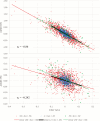Reducing the period of data collection for intake and gain to improve response to selection for feed efficiency in beef cattle
- PMID: 29401225
- PMCID: PMC6093535
- DOI: 10.1093/jas/skx077
Reducing the period of data collection for intake and gain to improve response to selection for feed efficiency in beef cattle
Abstract
Shortening the period of recording individual feed intake may improve selection response for feed efficiency by increasing the number of cattle that can be recorded given facilities of fixed capacity. Individual DMI and ADG records of 3,462 steers and 2,869 heifers over the entire intake recording period (range 62 to 154 d; mean 83 d; DMI83 and ADG83, respectively), DMI and ADG for the first 42 d of the recording period (DMI42 and ADG42, respectively), and postweaning ADG based on the difference between weaning and yearling weights (PADG) were analyzed. Genetic correlations among DMI42 and DMI83, ADG42 and ADG83, ADG42 and PADG, and ADG83 and PADG were 0.995, 0.962, 0.852, and 0.822, respectively. Four objective functions [feed:gain ratio in steers (FGS) and heifers (FGH); residual gain (RG); and residual feed intake (RFI)] based on DMI83 and ADG83 were considered. Indices using DMI42 and ADG42 (I42); DMI42 and PADG (IPW); and DMI42, ADG42, and PADG (IALL) were developed. Accuracy of the 5 EBV, 4 objectives, and 12 objective × index combinations were computed for all 12,033 animals in the pedigree. Accuracies of indices (IA) were summarized for animals with accuracies for objectives (OA) of 0.25, 0.5, 0.75, and 1. For the RG objective and animals with OA of 0.75, indices I42, IPW, and IALL had IA of 0.63, 0.55, and 0.67, respectively. Differences in IA increased with increased emphasis on ADG83 in the objective. Differences in IA between I42 and IPW usually increased with OA. Relative efficiency (RE) of selection on 42-d tests compared with 83 d was computed based on differences in IA and selection intensities of 5%, 25%, 50%, and 75% under the 83-d scenario, assuming 65% more animals could be tested for 42 d. For 25% selected for the RG objective, and animals with OA of 0.75, indices I42, IPW, and IALL had RE of 1.02, 0.90, and 1.10, respectively. As % selected, OA, and emphasis on DMI increased, RE increased. Relative efficiency varied considerably according to assumptions. One-half of the scenarios considered had RE > 1.15 with a maximum of 2.02 and 77% RE > 1.0. A shorter period of recording DMI can improve selection response for feed efficiency. Selection for the efficiency objectives would not affect PADG. It will be most effective if ADG over the period coinciding with intake recording and ADG over a much longer period of time are simultaneously included in a multiple-trait genetic evaluation with DMI and used in a selection index for efficiency.
Figures




References
-
- Ahlberg C. M., Kuehn L. A., Thallman R. M., Kachman S. D., Snelling W. M., and Spangler M. L.. 2016. Breed effects and genetic parameter estimates for calving difficulty and birth weight in a multibreed population. J. Anim. Sci. 94:1857–1864. doi:10.2527/jas.2015-0161 - PubMed
-
- Archer J. A., Arthur P. F., Herd R. M., Parnell P. F., and Pitchford W. S.. 1997. Optimum postweaning test for measurement of growth rate, feed intake, and feed efficiency in British breed cattle. J. Anim. Sci. 75:2024–2032. doi:10.2527/1997.7582024x - PubMed
-
- Archer J. A., and Bergh L.. 2000. Duration of performance tests for growth rate, feed intake and feed efficiency in four biological types of beef cattle. Livest. Prod. Sci. 65:47–55. doi:10.1016/S0301-6226(99)00181-5
-
- Arthur P. F., Archer J. A., Herd R. M., Richardson E. C., Exton S., Wright J. H., Dibley K. C. P., and Burton D. A.. 1997. Genetic and phenotypic variation in feed intake, feed efficiency and growth in beef cattle. Proc. Assoc. Adv. Anim. Breed. Genet. 12:234–237.
-
- Beef Improvement Federation 2016. Guidelines for uniform beef improvement programs. 9th rev. ed. Beef Improvement Federation, Prairie, MS.
Publication types
MeSH terms
LinkOut - more resources
Full Text Sources
Other Literature Sources
Research Materials

